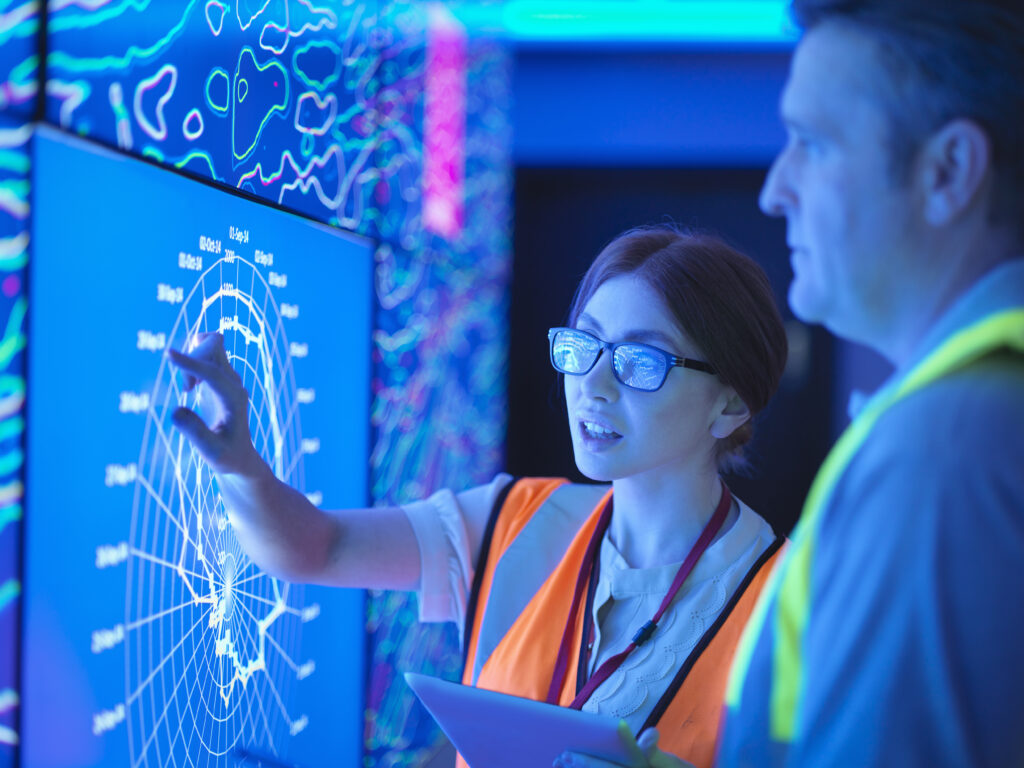
From pledge to action: Enabling the multidimensional energy transition with data and AI
There is no denying the need to accelerate the shift to cleaner energy, whether through cleaner hydrocarbons or renewables. Yet, the last few years have revealed that a global energy transition is more complex and less linear than we anticipated. While urgency builds for decarbonization, so does the demand for energy. Moreover, our economic growth and quality of life depend on the availability of affordable, cost-effective energy resources. Energy security is especially vital for the developing world, home to 80% of the global population.¹
To ensure that no one is left behind amidst rapid change, resolving the energy trilemma is a top priority for the industry with a focus on decarbonization, security, and reliable access to affordable energy.
Microsoft is dedicated to helping drive these changes. Our mission to empower every individual and organization on the planet is reflected in our sustainability commitments: To be carbon negative by 2030, and by 2050 to remove from the environment all the carbon the company has emitted since it was founded in 1975.

Microsoft for Energy and Resources
Achieve more in the energy and resources industry with trusted solutions from Microsoft.
We recognize that the future energy mix will be based on cleaner hydrocarbons and renewables, and we are working hard to make that vision a reality. The world needs to invest in more low-carbon energy and infrastructure to meet growing demand and offset the decline of oil production, which falls by 3% to 4% annually.² From technology innovations like generative AI to global collaboration across the energy industry, we are working hard to help drive global change and make that vision a reality.
I’d like to highlight some of those efforts, which include joining other changemakers at CERAWeek 2024 and partnering on a broad range of exciting initiatives.
Driving global change
To increase energy resilience based on cleaner hydrocarbon and renewables, we need innovations and collaboration across the globe. Last month at CERAWeek 2024 in Houston, Texas, CEOs, policymakers, financial communities, and technology leaders gathered to offer insights into the roadmap of this multidimensional energy transition.
We shared insights with industry partners and other global energy stakeholders on complex challenges and multidimensional strategies for energy transition. Microsoft leaders across energy, sustainability, cloud and AI, and security addressed a wide range of topics including the transformative impact of AI and other technologies.
CERAWeek 2024 takeaways
You can read more about the event and Microsoft speakers in last month’s energy blog on enabling energy transformation with AI. Key takeaways included the role of AI in creating a sustainable future, the multifaceted approach required to decarbonize electricity grids, carbon capture, methane mitigation, green hydrogen, and other strategies for addressing climate change. Strategies include nuclear licensing and the AI-methane framework developed with Accenture that brings point solutions together through a strong, affordable digital platform and an ecosystem of partners for end-to-end methane management.
You can read more about how Duke Energy teamed with Accenture and Microsoft to innovate a pioneering solution to meet goals for curbing methane emissions and potentially advance industry and regulatory standards.
Other distinguished speakers at CERAWeek 2024 included Accenture’s Chair and CEO Julie Sweet and Microsoft co-founder and philanthropist Bill Gates. Julie Sweet spoke about challenges and approaches for achieving decarbonization, the need to speed adoption of generative AI in the energy sector, and to dream big to advance the energy transition. She noted human innovation and participation are as important as the technology and data platform driving AI transformation.
Bill Gates discussed emerging clean technologies for investment and deployment, including nuclear and fusion energy, and carbon capture and storage (CCS). He also urged utilities to prepare for rising AI adoption, which he anticipates will increase power consumption, impacting chip makers and electricity cost. This was just one of many discussions at CERAWeek on the need to address AI energy use.
Supporting sustainable AI
During the past year, the pace of AI adoption has accelerated significantly, ushering in groundbreaking advances, discoveries, and solutions with the potential to help address humanity’s biggest problems. Alongside the incredible promise and benefits of AI, we recognize the resource intensity of these applications and the need to address the environmental impact from every angle.
In line with our commitment to responsible AI and our ambitious sustainability commitments, we’re determined to tackle this challenge so the world can harness the full benefits of AI. There are three areas where we’re deeply invested and increasing our focus. The first is optimizing datacenter energy and water efficiency. The second is advancing low-carbon materials, creating global markets to help advance sustainability across industries. And the third is improving the energy efficiency of AI and cloud services, empowering our customers and partners with tools for collective progress.
With AI we are enabling more efficient energy transmission and integration of renewable power. LineVision, an AI-enabled transmission line monitoring solution for expanding the capacity of existing overhead powerlines, is one of many Microsoft partners helping to accelerate the deployment of clean technology and a company which the Microsoft Climate Innovation Fund has invested in. After successfully deploying LineVision Dynamic Line Rating in the United States, global energy company National Grid implemented the technology in Great Britain. The technology has the potential to unlock enough additional capacity to power more than 500,000 homes and save an estimated GBP£1.4 million (US$1.7 million) annually.
Powerful partnerships for transformative solutions
Microsoft and its partners underscore the value of collaborating to accelerate the energy transition in a fair and orderly manner while addressing climate challenges. It is no longer about point solutions, but an end-to-end energy value chain driven by digital and AI which will help us move forward in a rapidly changing world. Recently, EDP Renewables and Volt Energy announced their collaboration with Microsoft to help under-resourced communities build climate resistance.³ Another clean energy initiative announced during CERAWeek between Microsoft, Google, and Nucor Corporation intends to accelerate development of nuclear, next-generation geothermal, clean hydrogen, and long-duration energy storage.⁴
Northern Lights, a partnership between the Norwegian government, Microsoft, and energy firms Equinor, Shell, and Total aims to standardize and scale CCS across Europe. A new CSS plant is expected to process up to 1.5 million tons of liquid CO2 annually and more than 100 million tons over time.
In the United States, Conservation Science Partners, bp, and Microsoft have partnered to create a digital platform for environmental and biodiversity monitoring in Washington state. Called the Cherry Point Refinery, the solution shows how technology can advance our understanding of ecosystems and enable sustainable practices. Other projects include accelerating permitting processes, reducing risk and capital for implementation of carbon capture projects, helping enable the sequestration process for permanent storage with companies like SLB, and supporting environmental credit services.
The future of clean energy and sustainability
I also want to recognize some amazing, underrepresented climate tech founders and CEOs featured at the Microsoft Agora House at CERAWeek who are driving the future of clean energy and sustainability. If it takes a village to raise a child, it will take companies of all sizes and backgrounds to address the growing need for energy and decarbonization by simultaneously meeting goals for energy security, accessibility, affordability, and climate change: Adrienne Pierce (New Sun Road, P.B.C.), Celine King (GreenIRR Inc.), Chidalu Onyenso (Earthbond), Christie Obiaya (Heliogen), Donnel Baird (BlocPower), Jhana Porter (Frakktal), Liz O’Connell (Arolytics), Nicholas Flanders (Twelve) and Steph Speirs (Solstice).
As part of our commitment to supporting the development of cutting-edge technologies to advance the energy transition, Microsoft is also proud to partner with Greentown Labs and Browning the Green Space’s ACCEL program to fund and mentor the next generation of underrepresented founders. Innovation is the key to solving the global climate challenge, and that innovation must be inclusive and equitable. Energy resilience depends on us all to come together to deliver reliable, accessible, and affordable access to a mix of cleaner hydrocarbons and renewable energy. Our complementary goals for achieving carbon-free energy by 2030 and empowering people and businesses to achieve more goes beyond technology.
The complex sustainability challenges the world faces today require multi-sector, multidisciplinary collaboration.
We’re not only providing productivity applications, cloud capabilities, cybersecurity, and innovative technologies like AI for end-to-end digital platforms, we’re also honored to be partners and collaborators for accelerating a more secure, equitable and sustainable future.
Learn more about Energy and Resources solutions with Microsoft
- Microsoft for Energy and Resources
- Accelerating sustainability with AI
- CERAWeek 2024
- COP28: Outcomes and Next Steps
- Transformative AI solutions powering the energy and resources industry
¹ The return of energy security | S&P Global




